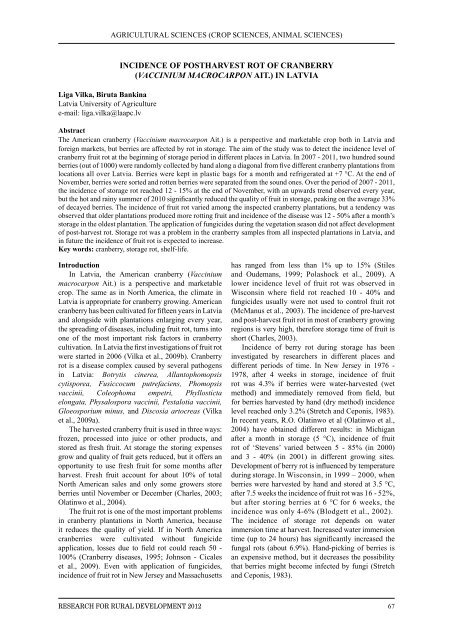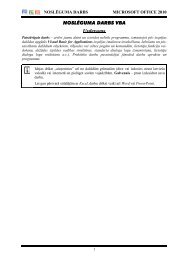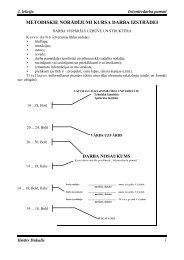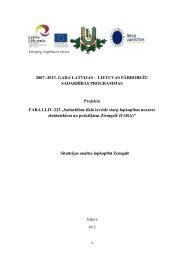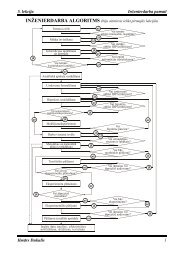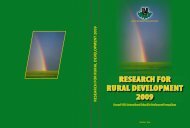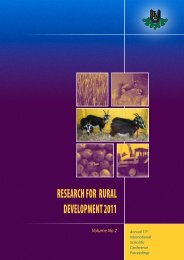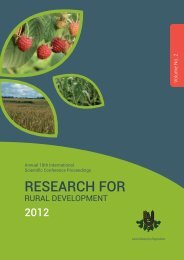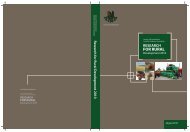LATVIA UNIVERSITY OF AGRICULTURE - Latvijas ...
LATVIA UNIVERSITY OF AGRICULTURE - Latvijas ...
LATVIA UNIVERSITY OF AGRICULTURE - Latvijas ...
- No tags were found...
You also want an ePaper? Increase the reach of your titles
YUMPU automatically turns print PDFs into web optimized ePapers that Google loves.
AGRICULTURAL SCIENCES (CROP SCIENCES, ANIMAL SCIENCES)Liga Vilka, Biruta BankinaLatvia University of Agriculturee-mail: liga.vilka@laapc.lvIncidence of POSTHARVEST Rot of CRANBERRY(Vaccinium macrocarpon Ait.) in <strong>LATVIA</strong>AbstractThe American cranberry (Vaccinium macrocarpon Ait.) is a perspective and marketable crop both in Latvia andforeign markets, but berries are affected by rot in storage. The aim of the study was to detect the incidence level ofcranberry fruit rot at the beginning of storage period in different places in Latvia. In 2007 - 2011, two hundred soundberries (out of 1000) were randomly collected by hand along a diagonal from five different cranberry plantations fromlocations all over Latvia. Berries were kept in plastic bags for a month and refrigerated at +7 °C. At the end ofNovember, berries were sorted and rotten berries were separated from the sound ones. Over the period of 2007 - 2011,the incidence of storage rot reached 12 - 15% at the end of November, with an upwards trend observed every year,but the hot and rainy summer of 2010 significantly reduced the quality of fruit in storage, peaking on the average 33%of decayed berries. The incidence of fruit rot varied among the inspected cranberry plantations, but a tendency wasobserved that older plantations produced more rotting fruit and incidence of the disease was 12 - 50% after a month’sstorage in the oldest plantation. The application of fungicides during the vegetation season did not affect developmentof post-harvest rot. Storage rot was a problem in the cranberry samples from all inspected plantations in Latvia, andin future the incidence of fruit rot is expected to increase.Key words: cranberry, storage rot, shelf-life.IntroductionIn Latvia, the American cranberry (Vacciniummacrocarpon Ait.) is a perspective and marketablecrop. The same as in North America, the climate inLatvia is appropriate for cranberry growing. Americancranberry has been cultivated for fifteen years in Latviaand alongside with plantations enlarging every year,the spreading of diseases, including fruit rot, turns intoone of the most important risk factors in cranberrycultivation. In Latvia the first investigations of fruit rotwere started in 2006 (Vilka et al., 2009b). Cranberryrot is a disease complex caused by several pathogensin Latvia: Botrytis cinerea, Allantophomopsiscytisporea, Fusiccocum putrefaciens, Phomopsisvaccinii, Coleophoma empetri, Phyllostictaelongata, Physalospora vaccinii, Pestalotia vaccinii,Gloeosporium minus, and Discosia artocreas (Vilkaet al., 2009a).The harvested cranberry fruit is used in three ways:frozen, processed into juice or other products, andstored as fresh fruit. At storage the storing expensesgrow and quality of fruit gets reduced, but it offers anopportunity to use fresh fruit for some months afterharvest. Fresh fruit account for about 10% of totalNorth American sales and only some growers storeberries until November or December (Charles, 2003;Olatinwo et al., 2004).The fruit rot is one of the most important problemsin cranberry plantations in North America, becauseit reduces the quality of yield. If in North Americacranberries were cultivated without fungicideapplication, losses due to field rot could reach 50 -100% (Cranberry diseases, 1995; Johnson - Cicaleset al., 2009). Even with application of fungicides,incidence of fruit rot in New Jersey and Massachusettshas ranged from less than 1% up to 15% (Stilesand Oudemans, 1999; Polashock et al., 2009). Alower incidence level of fruit rot was observed inWisconsin where field rot reached 10 - 40% andfungicides usually were not used to control fruit rot(McManus et al., 2003). The incidence of pre-harvestand post-harvest fruit rot in most of cranberry growingregions is very high, therefore storage time of fruit isshort (Charles, 2003).Incidence of berry rot during storage has beeninvestigated by researchers in different places anddifferent periods of time. In New Jersey in 1976 -1978, after 4 weeks in storage, incidence of fruitrot was 4.3% if berries were water-harvested (wetmethod) and immediately removed from field, butfor berries harvested by hand (dry method) incidencelevel reached only 3.2% (Stretch and Ceponis, 1983).In recent years, R.O. Olatinwo et al (Olatinwo et al.,2004) have obtained different results: in Michiganafter a month in storage (5 °C), incidence of fruitrot of ‘Stevens’ varied between 5 - 85% (in 2000)and 3 - 40% (in 2001) in different growing sites.Development of berry rot is influenced by temperatureduring storage. In Wisconsin, in 1999 – 2000, whenberries were harvested by hand and stored at 3.5 °C,after 7.5 weeks the incidence of fruit rot was 16 - 52%,but after storing berries at 6 °C for 6 weeks, theincidence was only 4-6% (Blodgett et al., 2002).The incidence of storage rot depends on waterimmersion time at harvest. Increased water immersiontime (up to 24 hours) has significantly increased thefungal rots (about 6.9%). Hand-picking of berries isan expensive method, but it decreases the possibilitythat berries might become infected by fungi (Stretchand Ceponis, 1983).Research for Rural Development 201267


